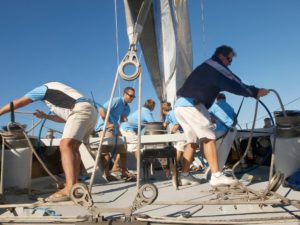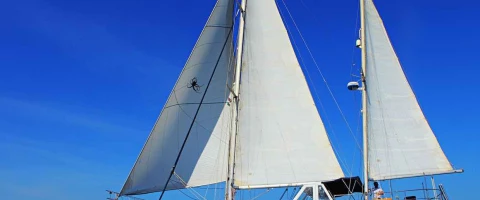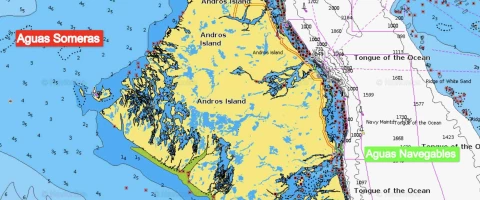For beginners that learn how to sail, the terminology used in the sailing community can seem overwhelming at first. Don't worry! With some practice, you'll be able to master the basics in no time.
Here are ten technical sailing terms that every beginner should know:
Port and Starboard
These terms refer to the left and right sides of a boat, respectively. "Port" is the left side, and "starboard" is the right side.
These terms are important for navigation and communication with other boats. As a sailor you have priority to pass another boat if you are positioned at "starboard". A boat at "Port" needs to divert from its position to not hinder the starboard boat's route.
On the picture above, the sails are at the port side while the sailor at the rudder is positioned at the starboard side of the boat. This implies that you have priority and other boats should change their route if they are about the hit you.
In addition, knowing the difference between starboard and port is essential for understanding navigation aids such as buoys and markers. These markers are color-coded, with red markers, indicating the port side of the channel. Green markers indicate, on their part, the starboard side. By understanding these markers, sailors can navigate through channels and waterways safely and efficiently.
Bow and Stern
The bow assigns the front of the boat, and the stern implies the back of a sailing boat. Knowing these terms will help you give and understand directions on the boat. In addition, knowing the location of the bow and stern is important for maneuvering the boat. For example, when docking a boat, the captain will need to approach the dock bow-first and then use the stern to secure the boat in place.
Windward and Leeward
Windward refers to the side of the boat that the wind is blowing on, while leeward is the opposite side. Understanding windward and leeward is important for adjusting sails and maneuvering the boat.
When sailing windward, sailors will need to trim the sails so that they catch the wind and create lift. This allows the boat to move forward against the wind. When sailing leeward, the sails need to be adjusted so that they catch the wind and push the boat forward.
Understanding windward and leeward is also essential for racing. In a sailing race, sailors will often try to gain an advantage by sailing in windward position relative to their competitors. This allows them to control the wind and potentially create a wind shadow that slows down their competitors.
Tacking
Tacking is a basic sailing maneuver that involves turning the boat's bow through the wind so that the sails switch from one side to the other. This helps the boat change direction and is an essential maneuver for sailing upwind.
Jibing
Jibing is another maneuver that involves turning the boat, but in this case, the boat turns away from the wind. This is used when sailing downwind, or easier said, when the wind comes from behind.
Halyard
A halyard is a rope or line that raises and lowers the sails. Each sail typically has its own halyard. The halyard also plays a critical role in adjusting the sail's tension and shape. By tightening or loosening the halyard, sailors can control the amount of draft or curvature in the sail. This helps to optimize its performance in different wind conditions.
Sheet
A sheet is a line that controls the angle of the sail. The main sheet controls the main sail, while the jib sheet controls the jib. The sheet is typically attached to the bottom or aft edge of the sail. Its tension can be adjusted to control the sail's shape and power.
The position and tension of the sheet can have a significant impact on the boat's speed and maneuverability. By adjusting the sheet's tension, sailors can control the amount of power in the sail. This helps optimize the boat's performance in different wind conditions. In general, tighter sheets create more power in the sail, while looser sheets allow the sail to flap in the wind.
Boom
The boom is a horizontal pole that extends from the mast and holds the bottom of the mainsail. It can swing from side to side, so it's important to be aware of its position while sailing.
Rudder
The rudder is a flat board or blade that is attached to the stern of the boat. It steers the boat trough the water and determines the direction.
The rudder works by deflecting water flow, which in turn changes the direction of the boat. When the rudder is turned to one side, water flows across it and creates a force that causes the boat to turn in the opposite direction.
In addition to providing steering control, the rudder also plays a critical role in maintaining the boat's stability and balance.
Headway
Another important technical sailing term is "headway." Headway refers to the forward motion of a vessel through the water. It's essential for understanding the vessel's speed and momentum.
Headway is measured in units of speed, such as knots or miles per hour. This is essential for calculating the time and distance required to reach a destination.
Understanding headway is crucial for safe navigation, especially in areas with strong currents or changing weather conditions. A vessel's headway can be affected by factors such as wind, currents, and waves. So, it's important for sailors to monitor their vessel's speed and adjust their course accordingly.
In addition to understanding headway, sailors also need to understand the terms "leeway" and "drift." Leeway refers to the sideways movement of a vessel caused by wind or current. Drift, on the other hand, refers to the overall movement of a vessel caused by wind and current combined. Understanding these terms is crucial for calculating the vessel's overall movement and making course adjustments as needed.
Learning these basic sailing terms will help you communicate with other sailors and better understand the various maneuvers involved in sailing. These terms are just the basics. You can expand your knowledge even more by searching for more specific sailing terms, but the best way to learn is by doing it.
Do you want to learn how to sail and boost your sailing skills? Or, are you looking to have your first sailing experience? Take the leap and discover our sailing day trips! Register for our "Competent Crew"sailing course or join one of our boat trips to watch Barcelona's famous skyline at sunset!





